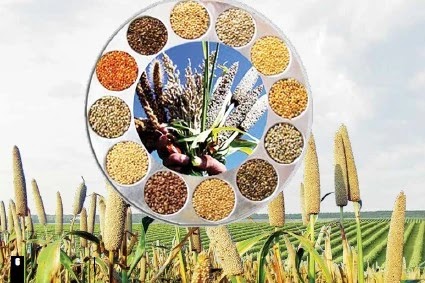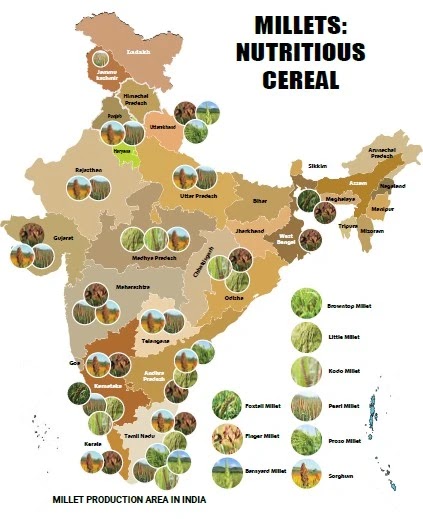-PM Narendra Modi
Context:
The United
Nations General Assembly at its 75th session in March 2021 declared
the International Year of Millets 2023 on the initiative of India,
which presided over a powerful group like the G-20.
- The International Year of Millets (2023) will spark a mass movement for a more secure, sustainable, and healthy future.
Key Points of International Year of Millets 2023:
- India proposed it with support of the United Nations and the Food and Agriculture Organization (FAO) for the launch of the International Year of Millets 2023.
- This proposal has also supported by 72 UN member countries.
- The International Year of Millets will raise awareness of millets' contribution to food security and nutrition, as well as motivate stakeholders to maintain and improve millet production.
- It will draw attention and encourage investment in research and development.
- Many countries around the work for millets to benefit farmers and consumers globally at the market.
- It will also promote the sustainable production of millets, while highlighting their potential to provide new sustainable market opportunities for producers and consumers.
- Coarse grains are good for the consumer, the farmer and the climate.
Global Distribution of Millets:
- India, Nigeria and China are the largest producers of millets in the world, distributing for more than 55% of the global production.
|
Millets Area and Production
Region-wise (2019) |
||
|
Area |
Area (Lakh Hectares) |
Production (Lakh Tonnes) |
|
Africa |
489 |
423 |
|
America |
53 |
192 |
|
Asia |
162 |
215 |
|
Europe |
8 |
20 |
|
Australia and New
Zealand |
6 |
12 |
|
India |
138 |
173 |
|
World |
718 |
863 |
- India is the largest producer and fifth largest exporter of millets in the world.
- India accounting for approximately 20% of global production.
In
Context of India for International Year of Millets 2023:
- The Government of India has launched an initiative to promote millets, or nutritious cereals, both in India and abroad.
- the Centre plans to facilitate the participation of exporters, farmers and traders in 16 international trade expos and buyer-seller meets.
- India’s Missions abroad will be taken in branding and promotion of Indian coarse cereals.
- The government has started preparing a five-year strategic plan to promote millets and their value-added products in the international market.
- APEDA has also signed an MoU with IIMR
for value addition and enhancing farmers' income.
- APEDA launched a variety of coarse grain products for all age groups at affordable prices ranging from Rs 5 to Rs 15 during Aahar Food Fair, Asia's largest B2B international food and hospitality fair.
Seven
Strong 'Sutras' Of International Year of Millets:
- Increase in production/productivity.
- Nutrition & Health Benefits.
- Processing, Culinary Development.
- Entrepreneurship/Startup/Group Development.
- Branding, Publicity, Spreading Awareness.
- International Reach.
- Policy Steps for Mainstreaming.
Millets
in India:
- The major millets grown in India are bajra (60%), jowar (27%), ragi (11%) and small bajra (2%) (As per 4th Advance Estimates 2021-22).
- India recorded a 27 percent increase in the production of coarse cereals in 2021-22.
- Rajasthan, Uttar Pradesh, Haryana, Gujarat, Madhya Pradesh, Maharashtra, Karnataka, Tamil Nadu, Andhra Pradesh and Telangana are the major producers of coarse cereals in India.
- 16
major types of
coarse cereals are produced and exported. These include Jowar, Bajra, Ragi,
Kangni, Cheena, Kodo, Sava/Sawa/Jhangora, Kutki, Kuttu, Chaulai and Brown Top
Millet.
- Under National Mission on Food Security (NFMS) program NFMS-POSHAK is being implemented in 212 districts of 14 states.
- In order to increase nutrition among children, the Central Government has requested the State Governments to explore the possibility of introducing coarse cereals under the PM Poshan Yojana, with priority given to those districts where coarse cereals are included in the diet as a culturally accepted habit.
- India's goal is not only to export millets, but also to reach out to the people and care for their health.
- In 2018, the National Year of Millet was observed in order to generate domestic and global demand and provide people with nutritious food.
WHAT IS COARSE GRAIN?
|
Benefits
of Millets:
Health:
- Helps in keeping the heart healthy. Suitable food for people suffering from diabetes. Prevents uncontrolled increase of sugar in the blood.
- They're also gluten-free and have a low glycemic index, so they're a great option for people with celiac disease or diabetes.
- Iron is found in abundance, so it is effective in increasing blood in the body.
- Helpful in strengthening the nervous system.
- Controls depression and low blood pressure. It also prevents substances that harm the body.
- Foxtail millet- Contains sufficient amount of calcium, strengthens bones and also helps in prevention of osteoporosis disease.
- Helpful in bone development and removing anaemia in the body.
- Rich in Vitamin E, protects body tissues from injury.
- Protects body cells from damage. Reduces the risk of colon cancer and heart disease.
Economy:
- They are food for millions of resources -constrained farmers and also fodder for their domesticated animals.
- The millet is also known as "coarse grain" or "poor grain.”
- The pandemic has highlighted the need to supplement the income of small and marginal farmers, and millets can be one of the best options for doing so.
Environment:
- Millet is a climate-resilient crop.
- It can be grown with little water.
- Millet crop contribute low carbon emissions.
- It can be grown in drought conditions.
Millets
are widely regarded as an ancient grain. It has a longer history than
the more modern cereals we consume. Millets were discovered in the Indus
Valley Civilization and the Vedas also make mention of coarse
grains. Millets have long been a part of Indian agriculture, culture, and
civilization. Millet can be found in food and drink in every part of the
country. When India declares the International Year of Millets, it becomes the
responsibility of the entire country to make it a mass movement. India
will emerge as the world's largest exporter, which will be nothing short of a gift
to humanity.
UPSC Civil Services Examination Prelims Previous Year
Question (PYQ)
Q.
With reference to ‘Initiative for Nutritional Security through Intensive
Millets Promotion’, which of the following statements is/are correct? (2016) 1.
This
initiative aims to demonstrate the improved production and post-harvest
technologies, and to demonstrate value addition techniques, in an integrated
manner, with a cluster approach. 2.
Poor,
small, marginal and tribal farmers have a larger stake in this scheme. 3.
An
important objective of the scheme is to encourage farmers of commercial crops
to shift to millet cultivation by offering them free kits of critical inputs
of nutrients and micro irrigation equipment. Select
the correct answer using the code given below: (a) 1
only (b) 2
and 3 only (c) 1
and 2 only (d) 1, 2
and 3 Answer (c) |
Source:
PIB



Post a Comment
Post a Comment
Thanks...keep in touch 🤟